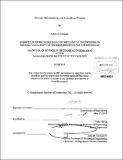Precision stationkeeping with azimuthing thrusters
Author(s)
Doroski, Adam D
DownloadFull printable version (4.598Mb)
Other Contributors
Massachusetts Institute of Technology. Dept. of Mechanical Engineering.
Advisor
Franz Hover.
Terms of use
Metadata
Show full item recordAbstract
Precision positioning of an unmanned surface vehicle (USV) in a nautical environment is a difficult task. With a dual azimuthing thruster scheme, the optimization of thruster outputs uses an online method to minimize the amount of error. It simplifies necessary calculations by the assumption that the rotating thrusters are always parallel thus making the system holonomic. The scheme accommodates for limitations in actuator outputs, including rotation limits and time-lagged thrusts and was implemented in a MATLAB simulation that tested its response to step errors and disturbance forces, similar to what it would encounter in actual implementation. It successfully achieved commanded outputs in all three degrees of freedom, typically within 25 seconds. It also rejects constant and sinusoidal disturbance forces. However, specific configurations arise where the USV, at times, is uncontrollable and the system only recovers after being further perturbed into a controllable configuration.
Description
Thesis (S.B.)--Massachusetts Institute of Technology, Dept. of Mechanical Engineering, 2011. Cataloged from PDF version of thesis. Includes bibliographical references.
Date issued
2011Department
Massachusetts Institute of Technology. Department of Mechanical EngineeringPublisher
Massachusetts Institute of Technology
Keywords
Mechanical Engineering.